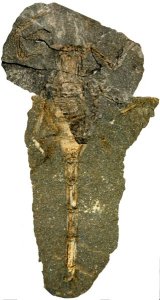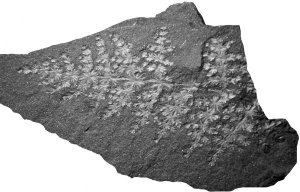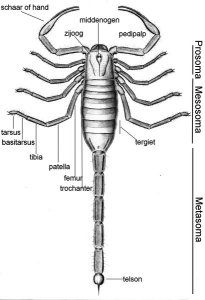A scorpion from the Carboniferous of the Piesberg
 On
Sunday 4 October 2006 a few members of the Dutch Geological Association made
an excursion to the large quarry in the Piesberg near Osnabrück (Germany).
It was raining cats and dogs and the finding was disappointing. Yet it was
going to be a memorable day, for one member of the group, Adri Delcour, saw
a somewhat strange fossil on a big block next to the road. She didn't know
what it was, but she thought it interesting enough to take it with her. With
difficulty she beat parts of the fossil from the solid rock. On
Sunday 4 October 2006 a few members of the Dutch Geological Association made
an excursion to the large quarry in the Piesberg near Osnabrück (Germany).
It was raining cats and dogs and the finding was disappointing. Yet it was
going to be a memorable day, for one member of the group, Adri Delcour, saw
a somewhat strange fossil on a big block next to the road. She didn't know
what it was, but she thought it interesting enough to take it with her. With
difficulty she beat parts of the fossil from the solid rock.
Inspecting the harvest at home she was amazed to see the head and two claws
of a scorpion on one part and the negative of the long tail on another one.
Furthermore there were some small pieces with parts of legs. The fossil was
not complete but with some 'photoshopping' it turned out to be possible to
produce a complete scorpion. Click on the photo.
Since then this rare find has been described scientifically by Dr. Jason
Dunlop from Berlin and Prof. Carsten Brauckmann from Clausthal-Zellerfeld
(Dunlop et al, 2008, see below).
Below is a photo of the fossil itself. The drawing has been made with
the camera lucida. This is an optical instrument to create an image which
can be traced on paper. The pictures are taken from the publication mentioned
above. Click on the left picture to get an enlargement.
The age of the fossil
Visiting again the finding place in the Piesberg, we found out that
the piece of rock from the fossil had vanished completely as a consequence
of the activities in the quarry. It can be assumed that the fossil originates
from a deposition above the coal seam
 Zweibänke (Westfalian
D). However, the diameter of the grains and the fossil content are different
from those of the regular plant layer. The grains are bigger and plant fossils
are scarce. The presence of exceptionally well preserved specimens of the
horsetail Annularia radiata is striking. Except these there were hardly
any plant remains in the rock. Zweibänke (Westfalian
D). However, the diameter of the grains and the fossil content are different
from those of the regular plant layer. The grains are bigger and plant fossils
are scarce. The presence of exceptionally well preserved specimens of the
horsetail Annularia radiata is striking. Except these there were hardly
any plant remains in the rock.
The conclusion can be made that the scorpion has been found in a deposition
above the regular plant layer of Zweibänke.
The Piesberg is known for his rich and diverse Upper Carboniferous flora.
But in recent years also more and more animal fossils are found. Still they
are very rare, but extensive collecting has yielded members of the following
groups: horseshoe crabs (Euproops), spiderlike animals
(Aphantomartus), Arthropleurida (a kind of giant myriapods:
Arthropleura), fish scales (Palaeoniscida), egg cases of sharks
(Palaeoxyris) and a tooth of a vertebrate. Freshwater shells also
occur, but there are rare.
Description of the fossil
 The body of
a scorpion can be divided into two parts: the cephalothorax or prosoma and
the abdomen or opisthosoma. The abdomen can be divided into the middle part
of the body or mesosoma and de very mobile 'tail' or metasoma with the telson.
The appendages are attached to the prosoma: the very small chelicerae (used
for reduction of the prey), the pedipalps or claws (with pincers for grasping
the pray) and four pairs of walking legs. The body of
a scorpion can be divided into two parts: the cephalothorax or prosoma and
the abdomen or opisthosoma. The abdomen can be divided into the middle part
of the body or mesosoma and de very mobile 'tail' or metasoma with the telson.
The appendages are attached to the prosoma: the very small chelicerae (used
for reduction of the prey), the pedipalps or claws (with pincers for grasping
the pray) and four pairs of walking legs.
As for the fossil: the prosoma and a part of mesosoma are preserved
in positive and the tail and the rear part of the mesosoma are preserved
in negative. A separate piece shows a leg with a claw. The total length of
the animal in life will have been about 11 cm.
Click on the drawing to see an enlargement of the reconstruction
and to get a more detailed description of the fossil.
Systematics
The characteristics described above fit exactly into the family of the
Eoscorpiidae.
The scorpion of the Piesberg resembles Eoscorpius carbonarius
(Meek & Worthen, 1868) from the Westfalian D of Mazon Creek (Illinois,
VS). The one from the Piesberg however is more slender. That's why the fossil
is called Eoscorpius cf. carbonarius for the time being. Cf.
is the abbreviation of Latin "confer", which means: compare. Wether the
differences with E. carbonarius from Mazon Creek are large enough
to justify a new species name or not, will become clear when the complete
Carboniferous scorpion group has been revised.
A point to mention is that there is a difference in preservation: the
Mazon Creek scorpion is embedded in a siderite concretion (an iron compound),
while the one from the Piesberg is preserved in shale. The way in which a
fossil has been preserved can have consequences for the form.
Another point is the fact that males and females of scorpions differ
from each other (sexual dimorphy). Male scorpions are somewhat more slender
and have a longer tail than female ones. So it is not impossible that this
specimen is a male and the Mazon Creek one is a female.
The scorpion is displayed in the Piesberg exhibition in the museum 'Am
Schölerberg' at Osnabrück (Germany).
Reference
Dunlop, J. A., Brauckmann, C. & Steur, H. (2008): A Late
Carboniferous fossil scorpion from the Piesberg, near Osnabrück,
Germany.
Fossil Record 11 (1) 2008, 25-32.
|